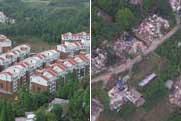China
Stronger economy gives catastrophe-hit China more time for rescue
Source: Xinhua | 05-27-2008 20:40
Special Report: Strong quake jolts SW ChinaBEIJING, May 27 (Xinhua) -- In the two weeks since an 8.0-magnitude quake devastated southwest China's Sichuan Province, the central government has striven to ensure fast and efficient rescue and relief operations.
It also brought the country's strengthening economy and the government's shift to put people first under scrutiny.
"Some 110,000 People's Liberation Army troops and armed police have been mobilized," Premier Wen Jiabao said on Saturday during his second visit to the quake zone. "The search and rescue operation has been conducted in every village."
The government had earmarked tens of billions of yuan for relief work, Wen said. A 75-billion-yuan (10.7 billion U.S. dollars) reconstruction fund had been set up, and would be added to in the next two years.
The powerful quake has claimed at least 67,183 lives, with 20,790 still missing. It also left at least 5 million people homeless, razing many counties and townships at the epicenter to the ground.
A preliminary investigation showed that 14,207 industrial firms in Sichuan suffered losses of 67 billion yuan (9.7 billion U.S. dollars), while centrally administered state-owned enterprises (SOEs) reported losses of more than 30 billion yuan.
Many analysts and organizations said total losses could amount to billions of yuan. U.S.-based risk assessors AIR said China's quake losses could exceed 140 billion yuan, while analysts at Chinese Academy of Sciences put the figure at 150 billion yuan.
Wang Tongsan, an economist with Chinese Academy of Social Sciences, said China's economic aggregate had increased exponentially since a powerful quake hit Tangshan, northern Hebei Province, more than 30 years ago.
The 7.8-magnitude Tangshan quake claimed more than 240,000 lives.
"The rapid development of China's economy since its opening-up, especially the double-digit growth in recent years, no doubt lays a solid foundation for government rescue and relief work this time," Wang said.
The government disaster relief fund had reached 16.63 billion yuan as of 2 p.m. on Monday, including 12.56 billion yuan from the central budget and 4.06 billion yuan from local budgets.
Entrepreneurs and the public also demonstrated their generosity in the wake of the disaster.
Zhang Xiangqing, in his late 30s, and his wife, Zhang Ronghua, surprised many Chinese by donating 100 million yuan for quake relief and reconstruction work.
The couple, who founded and own the Tianjin Rockcheck Steel Group Co., Ltd., said they would like to help people in quake zones to rebuild their homes and "earthquake-proof schools".
Theirs is typical of the unprecedented philanthropy of ordinary Chinese.
Public benevolence snowballed as the tragedy unfolded. By Monday noon, donations from home and abroad had reached 30.876 billion yuan, of which 9.05 billion yuan had been forwarded to the affected areas.
Such generous donations following a disaster are unprecedented in China in terms of the total figure and the broad participation of the public.
China's government management and technological capacities had been greatly improved along with the rapid economic development, which were also key factors behind the efficient rescue and relief, Wang told Xinhua.
The People's Liberation Army troops and armed police were sent for rescue work shortly after the quake. Premier Wen rushed to the quake zone within hours of the quake.
Qu Guosheng, chief engineer of the China seismological emergency center, said remote reconnaissance aircraft had provided reliable data for the best rescue routes after transportation and communications at the epicenter were cut.
He said life detectors, including thermal infrared equipment that could be used at night, rescue dogs, air cushions that could lift ten-ton objects, and hydraulic pressure clamps that could easily break reinforcing steel bars were also employed in the rescue.
These advanced technologies had saved precious time in the rescue effort, he added.
Ten days after the quake, more than 30,000 people had been relocated, and more than 6,000 were pulled alive from the rubble.
The Canadian-based Globe and Mail newspaper on May 20 reported, "Within hours of the quake, China was able to mobilize its vast human resources and target them at a massive disaster in a remote and forbidding region... an impressive display of China's economic prowess."
The government set its priority for economic development in 1978, and the policy was carried out in the following 30 years to make it possible to build up the national strength.
China's gross domestic product (GDP) reached 24.66 trillion yuan last year, 67 times that of 1978. Correspondingly, its per capita GDP rose from 381 yuan to 18,665 yuan, representing a 48-fold jump.
"The priority for economic development should not be changed," President Hu Jintao reiterated in a keynote speech delivered at the latest national congress of the Communist Party of China in October last year.
China is back on its path of economic endeavor, after days of all-out efforts to rescue survivors and three days of national mourning.
On the evening of May 21, when the mourning period was about to end, Premier Wen said at a meeting of the State Council, the Cabinet, that the country would attach equal importance to quake relief and reconstruction and to economic development.
As the rescue work draws to an end, China is taking on the toughest reconstruction task since 1976.
"But we have resolution, confidence in and are capable of overcoming all difficulties to succeed in both missions," the State Council agreed.
Editor:Xiong Qu



